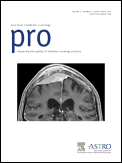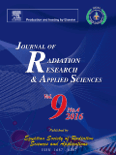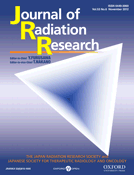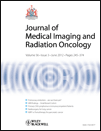
Physics & Imaging in Radiation Oncology
Scope & Guideline
Empowering Collaboration in Physics and Imaging for Better Patient Care
Introduction
Aims and Scopes
- Radiotherapy Physics and Dosimetry:
Research addressing the physical principles, dosimetry, and optimization of radiation therapy techniques, including advanced modalities such as proton therapy and stereotactic body radiotherapy. - Imaging Techniques in Radiotherapy:
Exploration of imaging modalities such as magnetic resonance imaging (MRI), computed tomography (CT), and positron emission tomography (PET) for treatment planning, real-time tracking, and adaptive radiotherapy. - Artificial Intelligence and Machine Learning Applications:
Studies focusing on the application of AI and machine learning for automated treatment planning, segmentation, and quality assurance in radiotherapy workflows. - Motion Management Strategies:
Research on techniques and methodologies to manage patient motion during treatment, ensuring precise targeting of tumors while minimizing exposure to surrounding healthy tissues. - Clinical Trials and Outcomes Analysis:
Investigations into the clinical efficacy of various radiation therapy techniques, including the evaluation of treatment outcomes and side effects in diverse patient populations. - Innovative Technologies and Equipment Development:
Development and validation of new technologies and devices that enhance imaging quality, treatment accuracy, and patient safety in radiation oncology.
Trending and Emerging
- Hybrid Imaging Techniques:
The integration of multiple imaging modalities, such as PET/MRI and CT/MRI, is gaining traction for its potential to improve treatment planning and monitoring of therapeutic responses. - Adaptive Radiotherapy:
An increasing focus on adaptive radiotherapy techniques, which allow for real-time adjustments to treatment plans based on patient-specific factors and tumor motion, is evident in recent publications. - AI-Driven Innovations:
The application of artificial intelligence and machine learning for automated segmentation, treatment planning, and quality assurance is rapidly trending, with numerous studies showcasing its benefits in enhancing precision and efficiency. - Personalized Medicine Approaches:
The movement towards personalized treatment strategies, including patient-specific dose optimization and tailored treatment plans based on genetic and imaging biomarkers, is emerging as a critical area of research. - Quality Assurance and Safety Protocols:
Enhanced focus on developing and validating comprehensive quality assurance protocols and safety measures in radiotherapy workflows reflects a growing commitment to patient safety and treatment efficacy.
Declining or Waning
- Traditional Radiotherapy Techniques:
Research focusing on conventional radiotherapy techniques, such as standard 3D conformal radiotherapy, is becoming less prominent as interest shifts towards advanced modalities that offer improved precision and personalization. - Basic Radiobiology Studies:
While still important, there seems to be a decreasing trend in basic radiobiology research as the focus shifts towards clinical applications and translational research that directly impacts patient care. - Single-Modal Imaging Studies:
There has been a noticeable decline in studies focusing solely on single-modal imaging techniques, like traditional CT, as the trend moves towards multi-modal imaging approaches that provide a more comprehensive view of tumor biology and treatment response. - Non-AI-Based Treatment Planning:
The emphasis on traditional, non-AI-based treatment planning techniques is waning, with a clear shift towards the integration of AI and machine learning to enhance planning efficiency and accuracy.
Similar Journals

Practical Radiation Oncology
Elevating Oncology Through Cutting-Edge ResearchPractical Radiation Oncology is a premier journal published by Elsevier Science Inc., focusing on the critically important fields of Oncology and Radiology, Nuclear Medicine, and Imaging. With an ISSN of 1879-8500, this journal serves as an essential resource for professionals and researchers dedicated to advancing the practice and research of radiation oncology. Established in 2011 and continuing through 2024, it has quickly gained recognition, achieving a prestigious Q2 ranking in Oncology and an exceptional Q1 ranking in Radiology, Nuclear Medicine, and Imaging as of 2023. The journal, housed in New York, USA, provides a platform for innovative research and practical insights, aimed at enhancing therapeutic practices and improving patient outcomes. As part of its commitment to fostering scientific dialogue, it also features a range of articles, reviews, and clinical studies that cater to the diverse interests of its readers. Hard-copy availability combined with digital access ensures a broad reach for the latest advancements in the field.

International Journal of Radiation Research
Exploring the Frontiers of Nuclear Medicine ResearchThe International Journal of Radiation Research, published by the IJRR-IRANIAN JOURNAL RADIATION RES, serves as a critical platform for researchers and professionals in the fields of radiology, nuclear medicine, and imaging technology. Since its inception in 2003, this peer-reviewed, open-access journal has focused on disseminating significant findings and advancements, contributing to the global discourse on radiation research. With an ISSN of 2322-3243, the journal offers valuable insights into emerging technologies and methodologies, maintaining a commitment to enhancing the understanding and application of radiation in medical science. Although currently positioned in the Q4 category across its scopes, the journal strives to elevate its impact by promoting high-quality research and innovative practices. The journal is accessible to a wide audience and encourages submissions from scholars worldwide, directly supporting the advancement of knowledge in radiological and ultrasound technology. For those seeking to explore and contribute to this dynamic field, the International Journal of Radiation Research represents an invaluable resource.

Journal of Radiation Research and Applied Sciences
Advancing knowledge in radiation science and its applications.Journal of Radiation Research and Applied Sciences, published by ELSEVIER, is a premier open-access journal since 2013, dedicated to advancing the understanding and application of radiation research in various fields. With an ISSN of 1687-8507, this journal serves as a vital resource for researchers, professionals, and students engaged in the study of the physical and biological effects of radiation, radiation physics, and its applications in medicine and industry. Its rigorous peer-review process ensures the dissemination of high-quality research that meets the growing demands for innovative solutions in radiation science. By offering comprehensive access options, the journal promotes an inclusive approach to sharing knowledge with the global community. The Journal of Radiation Research and Applied Sciences stands out as a key platform for scholarly communication, fostering advancements that impact both theory and practice in the rapidly evolving landscape of radiation research.

JOURNAL OF RADIATION RESEARCH
Bridging disciplines in the ever-evolving field of radiation research.JOURNAL OF RADIATION RESEARCH, published by Oxford University Press, is a prominent peer-reviewed journal focusing on the diverse fields of radiation science, including health, toxicology, and radiology. Since its inception in 1960, this open-access journal has provided a critical platform for the dissemination of high-quality research, making it accessible to a global audience of researchers, professionals, and students. With a consistent track record, the journal holds an impressive impact factor and is categorized in Q2 of Radiation studies and Q3 in Health and Toxicology as per the 2023 rankings, reflecting its influential role in shaping contemporary discourse in the field. The journal also boasts notable rankings within Scopus, further underscoring its importance in advancing knowledge and innovations related to radiation. Spanning from 1960 to 2024, the JOURNAL OF RADIATION RESEARCH remains at the forefront of scientific exploration and is essential reading for anyone committed to advancing the understanding of radiation and its effects.

Journal of Medical Imaging and Radiation Oncology
Pioneering Discoveries in Cancer Treatment and ImagingJournal of Medical Imaging and Radiation Oncology, published by WILEY, is a pivotal resource in the fields of oncology and medical imaging. With an impact factor reflective of its commitment to advancing research, the journal has maintained a robust reputation since its inception in 2008 and continues to thrive through 2024. It is indexed with an insightful ranking, with a Q2 classification in Radiology, Nuclear Medicine and Imaging, affirming its importance in these disciplines. This journal not only serves as an open access platform, allowing extensive reach and accessibility, but also fosters a scholarly community dedicated to the innovation of imaging techniques and radiation oncology practices. As a key player in disseminating crucial findings and advancements, it appeals to researchers, clinicians, and students who aim to contribute to the evolving landscape of medical imaging and cancer treatment methodologies. The journal is based in Australia, at 111 River St, Hoboken, NJ, and invites submissions that push the boundaries of current knowledge in this critical area of healthcare.

Zeitschrift fur Medizinische Physik
Pioneering research for a healthier tomorrow.Zeitschrift für Medizinische Physik is a prominent academic journal dedicated to advancing the field of medical physics, published by ELSEVIER. With an ISSN of 0939-3889 and an E-ISSN of 1876-4436, this journal has transitioned to an Open Access model since 2022, ensuring that cutting-edge research is readily accessible to a global audience. Based in Germany at RADARWEG 29, 1043 NX AMSTERDAM, NETHERLANDS, the journal encompasses a wide array of topics related to medical physics, thereby facilitating interdisciplinary collaboration. Its impressive categorization includes Q3 in Biophysics and Q2 in both Radiological and Ultrasound Technology and Radiology, Nuclear Medicine and Imaging as of 2023, reflecting its significant contribution to the scientific community. In the Scopus rankings, it holds respectable positions in its categories: #143/333 in Radiology and Nuclear Medicine, #28/63 in Radiological and Ultrasound Technology, and #83/152 in Biophysics, demonstrating its influence and reach. The journal's focus is not only on publishing innovative research but also on fostering education and discussion among researchers, professionals, and students in medical physics. Zeitschrift für Medizinische Physik invites scholars at all levels to contribute and engage with the content that shapes the future of this vital field.

Physical and Engineering Sciences in Medicine
Innovating Solutions at the Intersection of Science and MedicinePhysical and Engineering Sciences in Medicine is an esteemed peer-reviewed journal published by SPRINGER, dedicated to advancing the interdisciplinary fields of biomedical engineering and biophysics. With an ISSN of 2662-4729 and an E-ISSN of 2662-4737, this journal has carved a niche for itself since its inception in 2020. Situated in the Netherlands, it serves as a global platform for innovative research and developments that bridge the physical sciences and engineering with medical applications. The journal boasts a commendable range of quartile categorizations, highlighting its impact in various sectors including Instrumentation (Q1), Radiology (Q2), and Biotechnology (Q2). Its Scopus rankings further emphasize its relevance and quality, placing it in the top 15% in several categories. Being an Open Access title, it promotes the dissemination of knowledge, ensuring that vital research is accessible to all, thereby fostering collaboration among researchers, professionals, and students alike. The journal's objectives include promoting cutting-edge research, enhancing biomedical technology, and addressing complex health challenges through innovative engineering solutions, establishing it as a vital resource in the scientific community.

Journal of Radiosurgery and SBRT
Transforming Patient Care through Cutting-edge TherapiesJournal of Radiosurgery and SBRT is a dedicated platform for advancing the field of radiosurgery and stereotactic body radiation therapy (SBRT), published by OLD CITY PUBLISHING INC. With its ISSN 2156-4639 and E-ISSN 2156-4647, this journal serves researchers and practitioners keen on the latest findings and methodologies in the domains of radiological technology and surgical oncology. Operating from Spain, the journal has established itself within notable quartiles, ranking Q3 in 2023 across categories including Radiological and Ultrasound Technology, Radiology, Nuclear Medicine and Imaging, and Surgery. The journal is indexed in Scopus, with rankings that place it at #311 in Medicine Surgery and #232 in Medicine Radiology categories, reflecting its significance in the academic community. Although it does not currently offer an open-access model, the Journal of Radiosurgery and SBRT aims to foster innovation and collaboration, making it an essential resource for those involved in cutting-edge research and clinical practice in radiosurgery.

MEDICAL PHYSICS
Navigating the Future of Healthcare Through Scientific InquiryMEDICAL PHYSICS, published by WILEY, stands as a leading journal in the fields of biophysics, medicine, and radiology, boasting an impressive impact factor and classified within the prestigious Q1 category across multiple relevant domains. With its ISSN 0094-2405 and E-ISSN 2473-4209, the journal has been a vital resource since its inception in 1974, leading the discourse well into 2024. Hailing from the United States, MEDICAL PHYSICS serves a diverse academic audience, comprising researchers, clinicians, and students eager to engage with the latest advancements and methodologies. The journal’s authoritative presence is underscored by its Scopus rankings, placing it among the top percentile in both Medicine and Biophysics, marking it as an essential scholarly platform for innovative research and critical reviews. While not currently an Open Access journal, its commitment to curating high-quality articles ensures that readers can access groundbreaking insights into medical imaging, treatment protocols, and the theoretical underpinnings of medical physics. Explore the intersection of technology and healthcare through the esteemed pages of MEDICAL PHYSICS.

Japanese Journal of Radiology
Exploring Innovations in Imaging and Nuclear MedicineThe Japanese Journal of Radiology, published by SPRINGER, serves as a premier platform for disseminating cutting-edge research and clinical advancements in the fields of radiology, nuclear medicine, and imaging. With an ISSN of 1867-1071 and E-ISSN 1867-108X, this journal has established itself as a vital resource for practitioners, researchers, and students alike. Renowned for its high-quality peer-reviewed articles, it currently enjoys a respectable impact factor within the Q2 category of Scopus rankings, placing it in the 69th percentile among 333 journals in its field. The journal has seen consistent convergence of research from 2009 to 2024, further underscoring its commitment to advancing the understanding of radiological practices. Importantly, the journal offers Open Access options to facilitate widespread dissemination of knowledge, ensuring that vital research reaches its audience without barriers. Addressed in Japan, the Japanese Journal of Radiology plays a critical role in enhancing the global discourse on medical imaging, making it an essential resource for anyone engaged in this dynamic field.